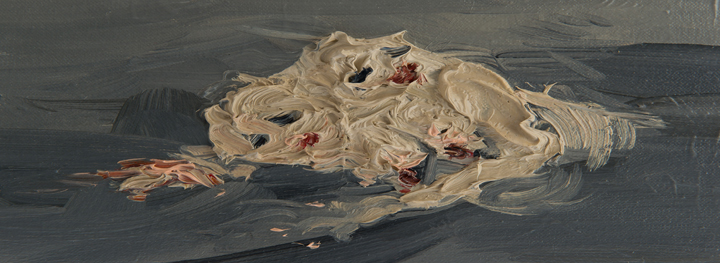Art & Art History
Gush

The first in a series of three UIC MFA Thesis Exhibitions in Studio Arts, Photography, Moving Image, and New Media Arts.
Artists: Soheila Azadi, Jessica Cobb, Meg Nafziger, Lauren C. Sudbrink
Elements converge in a charged formlessness, bodies defy their bounds, and vessels are saturated to the point of overflowing. The works in Gush touch, congeal, and drip from above. Soheila Azadi uses performance art and performative installations to materialize and narrate stories about women ’s everyday struggles. Race, religion, gender, sexuality, and ethnicity intersect in works that allude to social structures of Iran and those of western countries, but traverse boundaries outside of restrictive, gendered expectations placed upon the body. Conflating sculpture and the human experience, Jessica Cobb invents systems with material and technology that generate a charge, providing a platform between people and space that establishes frequencies of awareness. Meg Nafziger ’s paintings and drawings erase the form of the female archetype. Liberated from formal anxieties, her bodies droop, splay, and coalesce in erotic swirls of paint. The skin of the body and the skin of the photograph ’s surface in Lauren C. Sudbrink ’s evolving photographic processes have an ethereal, ghostly presence. Her raw and delicate sculptures hover above the ground, showing their flaws and intricacies, while asserting their energy and physicality. The haptic, sensuous works in Gush are activated by bodies, by movement, and by the charge of elements that make up experience.
Soheila Azadi is a storyteller. Her work is a transient social sculpture that shifts and transforms spaces while illuminating social issues. She generates settings where people experience community, in which they develop relationships and empower themselves and others. Her experiences as a Muslim woman living under a theocracy in Iran, and as an immigrant who is living in the U.S., have motivated her to research the spatial separations between the sexes, as well as the segregation between cultural identities. In her work, the seemingly different subjects of integration and separation are intertwined and environments where participants can speak for themselves are instigated.
Observing and contributing to the consciousness of what it is to be “another” is a theme that drives Jessica Cobb’s interest in defining sculpture as the human experience. The work provides a platform between people and space that establishes frequencies of awareness. Through research she invents systems with material and technology that generate a charge. They instigate a magnetism to be completed by the polar complement, the viewer. The art engages environments with a generative effect- evolving science with art, culturing innovation through community.
Meg Nafziger ’s paintings and drawings investigate touch and its relationship to desire, intimacy and issues of representation. She received her BFA from The School of the Art Institute of Chicago in 2006.
Using a myriad of photographic processes, Lauren C. Sudbrink transforms, dislocates and abstracts the performative body. She works to conflate the skin of the human body with that of film, the skin-like surface of the photographic paper, and the traces of light that move between said skins. While traditional photographic methods mirror the subject of the body, she synthesizes the skin as cellular and the films as celluloid; all the way down to the particles that make up a body ’s energy via surfaces and light sensitivity. Her works attempt to capture experiences that have never entered memory in the first place, to blur the trace of the subject and the boundaries between it and the space it occupies, and render the invisible, visible.
The 2015 MFA Thesis Exhibitions are supported by Gallery 400 and the School of Art & Art History at the University of Illinois at Chicago.
Soheila Azadi is a storyteller. Her work is a transient social sculpture that shifts and transforms spaces while illuminating social issues. She generates settings where people experience community, in which they develop relationships and empower themselves and others. Her experiences as a Muslim woman living under a theocracy in Iran, and as an immigrant who is living in the U.S., have motivated her to research the spatial separations between the sexes, as well as the segregation between cultural identities. In her work, the seemingly different subjects of integration and separation are intertwined and environments where participants can speak for themselves are instigated.
Observing and contributing to the consciousness of what it is to be “another” is a theme that drives Jessica Cobb’s interest in defining sculpture as the human experience. The work provides a platform between people and space that establishes frequencies of awareness. Through research she invents systems with material and technology that generate a charge. They instigate a magnetism to be completed by the polar complement, the viewer. The art engages environments with a generative effect- evolving science with art, culturing innovation through community.
Meg Nafziger ’s paintings and drawings investigate touch and its relationship to desire, intimacy and issues of representation. She received her BFA from The School of the Art Institute of Chicago in 2006.
Using a myriad of photographic processes, Lauren C. Sudbrink transforms, dislocates and abstracts the performative body. She works to conflate the skin of the human body with that of film, the skin-like surface of the photographic paper, and the traces of light that move between said skins. While traditional photographic methods mirror the subject of the body, she synthesizes the skin as cellular and the films as celluloid; all the way down to the particles that make up a body ’s energy via surfaces and light sensitivity. Her works attempt to capture experiences that have never entered memory in the first place, to blur the trace of the subject and the boundaries between it and the space it occupies, and render the invisible, visible.